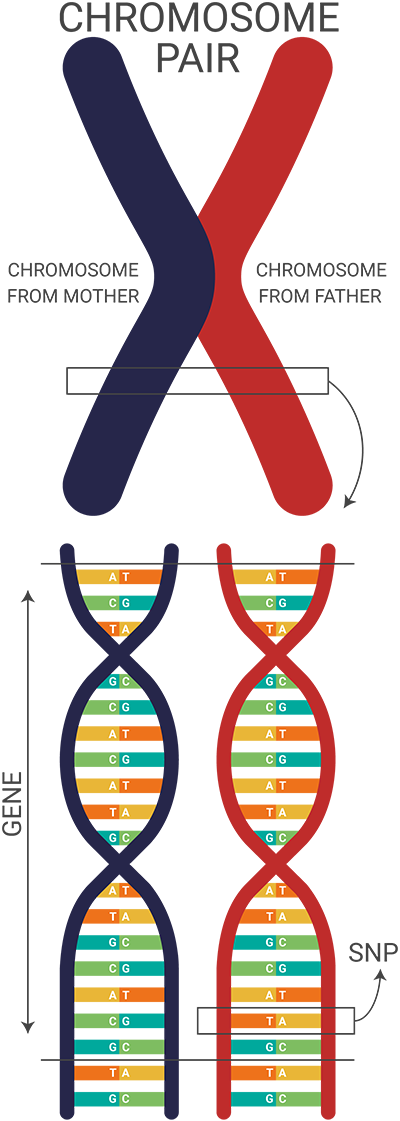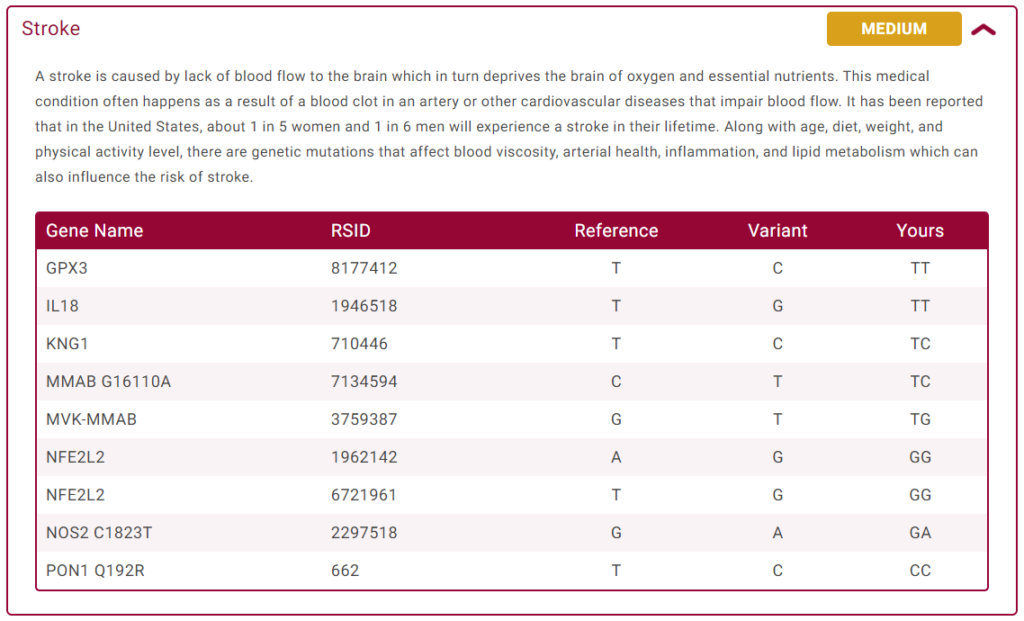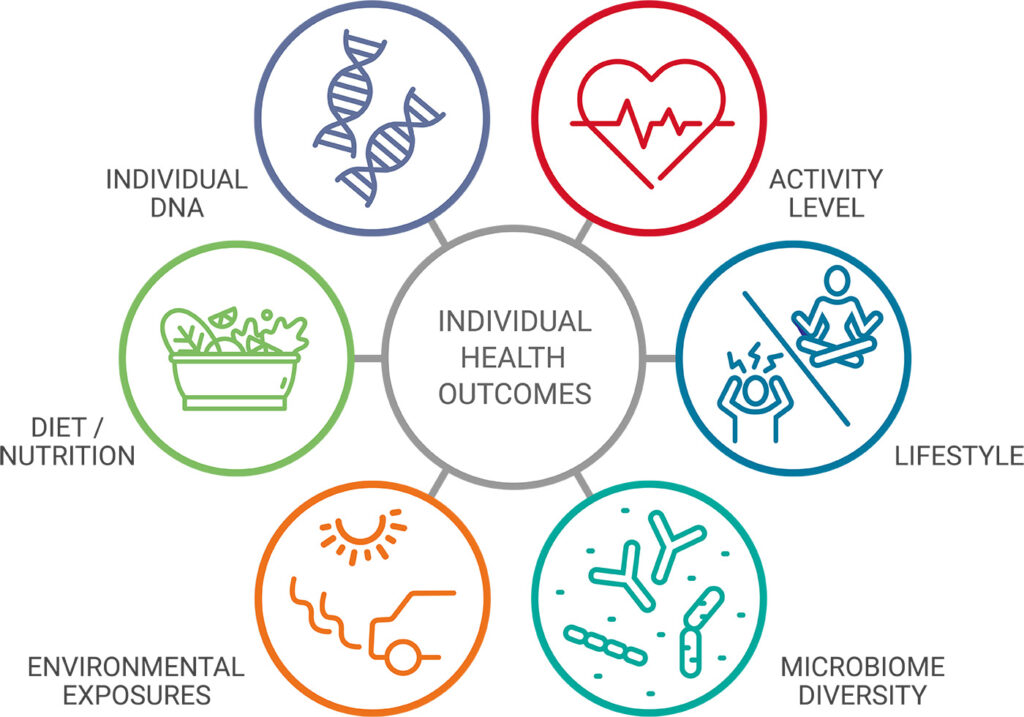The human genome is the coded biological blueprint that makes you, well, YOU. This code is determined by the order of four building blocks, called nucleotides: adenine (A) and thymine (T), which are always paired together, and guanine (G) and cytosine (C) which are always paired together. These pairs of nucleotides interlock to create the double helix structure of DNA (deoxyribonucleic acid). DNA is organized into larger structures, called chromosomes. Contained within these chromosomes are regions called genes, which hold the information that tells your cells to make specific cellular components, known as proteins, that work together to make you. The proteins your body makes, based on your DNA, creates the unique combination of traits and features that define you, such as height, eye color, and hair color.
Humans have 23 pairs of chromosomes. Each pair consists of one chromosome that you inherit from your mother and one from your father. This is how you can end up looking similar to your biological parents. So while your genome has 20,000-25,000 genes contained in your chromosomes among a total of 3.2 billion As, Ts, Cs and Gs, you actually have two distinct copies of every part of your genome. That is an enormous amount of information. To interpret all of this information, it has been organized into the human reference genome, which is the standard order of all human nucleotides that geneticists use as a template for what is considered as the “normal” human genome.
How Your Genome is Unique
Even though there is a standard human genome, your genome can and will vary at approximately 4-5 million nucleotide positions. This vast amount of variation is precisely why this test measures your entire genome, and not just a few select spots like other genetic tests. If the order of the nucleotides (As, Ts, Cs, and Gs) in a gene are altered it can result in changes in the production, function, structure, or location of the encoded protein. Altered nucleotides outside of genes can also result in wildly different biological outcomes. When a nucleotide differs from the nucleotide found in the human reference genome at the same position, it is referred to as a single nucleotide polymorphism (SNP) or a variant. When a SNP is identified it is given a unique universal identification number, known as a rsID, that allows researchers and databases to refer to that specific SNP. In this report, the nucleotide found in the human reference genome will be referred to as the reference allele for each SNP and the alternate nucleotide will be referred to as the variant allele.
How Can Your Genome Affect Your Health?
If a SNP alters a protein enough, it can impair or enhance important mechanisms in the body which then influences the potential for certain health conditions to arise. In this report, each SNP has been characterized as either a risk or beneficial SNP based on what the variant does to the gene. There are two copies of each gene, called alleles, one on each chromosome, so every person has the potential to carry zero, one, or two variant alleles at each SNP site which influences how much the SNP may impact their health. The combination of alleles you carry is known as your genotype.
Illustration of Genotype and Disease Risk
For example, if SNP rs123456 had the variant allele as A and the reference allele as G, an individual could have a genotype where they carry zero variant alleles (G/G), a genotype where they carry one variant allele (A/G), or a genotype where they carry two variant alleles (A/A). If the effects of the variant allele “A” are linked to an increased risk of developing a disease, a person with a G/G genotype would have a normal risk of developing the disease; a person with a A/G genotype would have an increased risk of developing the disease; and a person with a A/A genotype would have the same or an increased risk of developing the disease relative to the A/G genotype.

Understanding Your Personal MY DNA Report
This report includes 12 panels and analyzes over 1500 single nucleotide polymorphisms (SNPs) against your entire genome to give you the most comprehensive genetic test. The clinical significance of each SNP has been manually curated by our trained genetics team and is based on the latest peer reviewed scientific literature. The invaluable information in the MY DNA report will allow you to learn about your unique genetic makeup and how it can play a role in your well being.
How The MY DNA Report Interprets Your Health Risk Using Your Genome
In this report, the risk impact associated with each SNP is calculated based on the latest available peer reviewed studies and then taken into account to determine the priority of each trait based on your unique genome. This ranking is displayed on your report for each trait/condition as High, Medium, Low or Superpower to help you determine which traits are of highest priority to support immediately and which traits may act as your personal “superpowers”. The traits listed as high priority are things that you want to pay the most attention to as these are the traits your genetics put you at highest risk for developing symptoms or being affected by. This information not only helps you determine where your highest priority of care lies, it can also help you build your own personalized supplement protocol based on your DNA. If a high priority ranking for a specific trait is concerning to you, seeking further testing through a medical professional to determine the status of the condition is strongly advised.
In your MY DNA report, some SNPs are marked with a red dot. This is used to highlight SNPs that are associated with a significantly elevated risk for certain health conditions. When you see a red dot next to one of these SNPs, it means that this specific SNP has been linked to at least double the typical odds of being affected by its associated health issue compared to the general population. In essence, the red dot identifies SNPs that could have a stronger impact on your health because they indicate a higher level of genetic predisposition.
The purpose of highlighting these variations is to draw your attention to them so you can actively make lifestyle changes, such as adjustments to your diet, exercise, or environment, to potentially epigenetically influence the expression of that gene. This means your choices could help turn the “volume down” on the gene’s activity, which may help you alter or mitigate the potential health outcomes indicated by the higher risk.
Example of Personal DNA Report Details

Epigenetics Factors: Nature vs. Nurture
Since the MY DNA test is strictly reporting on what is found in your genome, it is not intended to be used as a clinical diagnostic tool. There are multiple epigenetic factors, including diet, lifestyle choices, physical activity level, microbiome diversity, and environmental exposures, that can also influence your health risks by affecting gene expression. This means that although these reports may show that you are at high risk for a certain trait based on your DNA, they may not currently, or ever, present symptoms based on your daily life choices and environmental exposures. There are also some traits included in the reports that may be specific to a male or female, however we have included them as an extra insight into potential risks that you could pass on to your offspring. If a certain trait is concerning to you, we encourage you to consult a medical professional for more information and further testing options.

MY DNA Report Disclaimer
Although the information and assessments in this report have been manually curated and meticulously reviewed by our genetics team, this report has not been evaluated by the Food and Drug Administration. Therefore, this report is intended for informational use only. It is not intended to diagnose, treat, cure, or prevent any disease. Any treatment decisions based on these results should only be made after consulting a licensed medical professional who can confirm any concerning results with additional clinical testing. Furthermore, before implementing any recommendations be sure to inform your practitioner of all medical information including relevant lifestyle choices, family medical history, pre-existing medical conditions, and any supplements or medications you are already taking, as they can influence your personal health needs.
